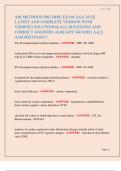P a g e |1
AIR METHODS PRE-HIRE EXAM 2024-2025||
LATEST AND COMPLETE VERSION WITH
VERIFIED SOLUTIONS|| ALL QUESTIONS AND
CORRECT ANSWERS ALREADY GRADED A+|| ||
ASSURED PASS!!!
S/S decompensating bradydysrythmias - ANSWER> SBP <90 AMS
medication NOt to give decompensating bradydysrythmias with 2nd degree HB
type II or CHB or heart transplant - ANSWER> atropine
S/S decompensating tachydysrythmias - ANSWER> SBP <90 AMS
treatment for decompensating tachydysrythmias - ANSWER> consider sedation /
synchronized cardioversion (100 J)
becks triad indicates - ANSWER> cardiac tamponade
becks triad for cardiac tamponade - ANSWER> hypotension, muffled/distant
heart sounds, jugular venous distention (JVD)
elevated lab values in rhabdomyolysis (crush injury) - ANSWER> CK, K+,
Bun/creatinine, AST/ALT
markers of cardiac reperfusion after fibrinolytic therapy include relief of chest
pain, normalization of ST segment changes - ANSWER> reperfusion dysrythmias
such AIVR
Page | 1
, P a g e |2
normal CVP range - ANSWER> 2-6 mmHg
normal cardiac index - ANSWER> 2.5-4.3
normal PAWP (pulmonary artery wedge pressure) - ANSWER> 6-12 mmHg
normal SVR (systemic vascular resistance) - ANSWER> 800-1200
normal coronary perfusion formula - ANSWER> aortic diastolic pressure (ADP),
LCeft ventricular end-diastolic pressure (LVEDP)
hemodynamic readings: hypovolemic - ANSWER> CVP: low , cardiac index:
low, PAWP: low, SVR: high
shock index formula - ANSWER> SI=HR/SBP (systolic BP)
normal shock index - ANSWER> 0.5-0.7
steps to determine shock/condition the PT is presenting - ANSWER> 1. SVR,
2a.SVR <800 think distributive, 2b. cardiac index: high= septic, low=neurogenic
(brady or normal HR)/ anaphylactic (tachycardia) OR SVR > 1200 (hypovolemic),
CVP: low= hypovolemic, high= cardiogenic shock or RVMI, PCWP: low= RVMI,
high= cardiogenic
hemodynamic readings: cardiogenic - ANSWER> CVP: high, Cardiac index: low,
PAWP: high, SVR: high
Page | 2
, P a g e |3
hemodynamic readings: RVI - ANSWER> CVP: high, Cardiac index: low,
PAWP: low, CVP: high
hemodynamic readings: septic - ANSWER> cardiac index: high, SVR: low, CVP:
low
hemodynamic readings: neruogenic - ANSWER> cardiac index: low w/ normal
HR or bradycardia, SVR: low
hemodynamic readings: anaphylactic - ANSWER> cardiac index: low w/
tachycardia, SVR: low
hemodynamic finding is expected in a PT with RIGHT ventricular MI -
ANSWER> elevated CVP
S/S pericarditis - ANSWER> classic sign: friction rub, CP radiating to back, CP
relieved by sitting up/forward, CP worsening when laying flat
treatment of pericarditis & what not to give - ANSWER> O2 administration,
NSAIDS (toradol), corticosteroids. do NOT give: nitroglycerin
S/S of endocarditis - ANSWER> olsers nodes (red painful pads of digits),
janeway lesions fat, purpuric, non painful hands and feet, subconjuctivital
hemorrhages (eye roth spots), flu like symptoms/fever, fatigue/night sweats,
CP/SOB
discrepancy between blood pressure values and pulse strength, a loud systolic
murmur, and mediastinal widening on CXR are symptoms of - ANSWER> aortic
disruption/ dissection
Page | 3
, P a g e |4
aortic disruption/dissection should be considered in what kind of trauma -
ANSWER> severe deceleration MVC
s/s of aortic dissection/rupture - ANSWER> tearing/ripping chest pain in
hypertensive pts that radiates to the back, systolic murmur, mediastinal widening,
tracheal deviation, localized bulge on aortic notch
endocarditis triad - ANSWER> fever, heart murmur, anemia
medications for aortic dissection - ANSWER> nipride and beta-blockers
levines sign and its indication - ANSWER> clutching CP, indication: cardiac
origin
kernigs sign and its indication - ANSWER> laying flat, flex hip 90 degrees and
then attempts to extend lower leg at knee, indication: meningitis
brudzinski sign and its indication - ANSWER> hip and knee flexing while raising
pts head and pushing on chest, indication: meningitis/subarachnoid hemorrhage
murphys sign and its indication - ANSWER> RUQ ABD pain w/ inspiration,
indication: cholecystitis (galbladder)
grey turners sign and its indication - ANSWER> retroperitoneal bruising,
indication: pancreatitis or ABD trauma
Page | 4




